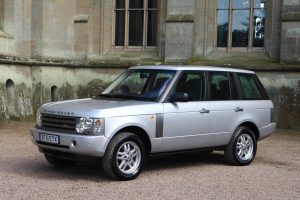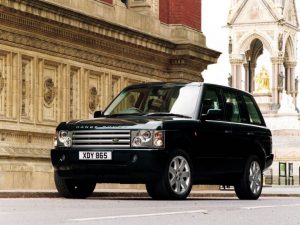Recalls: Land Rover L322 Range Rover
Overview
Manufacturers, or importers, issue recalls for defects or faults which have the potential to cause injury. Generally, manufacturers will inform the original buyers if their vehicle is subject to a recall and of the steps required to remedy the defect or fault. Please note that the recalls below (if any) are for Australian-delivered vehicles only. Furthermore, the number of recalls should not be taken as an indication of a model’s reliability or its safety more generally.
Recalls: Land Rover L322 Range Rover
2002-04 model year Land Rover L322 Range Rover: fuel filler neck
In October 2004, a recall was issued for Land Rover L322 Range Rover models with V8 petrol engines produced from model year 2002 to model year 2004 and in the VIN range 2A 105195 to 4A 148767. For affected vehicles, the fuel filler neck was unrestricted and needed to be replaced with a restricted fuel filler neck (PRA 2004/7280).
2005 model year Land Rover L322 Range Rover: television operation
In April 2005, a recall was issued for MY2005 Land Rover L322 Range Rover models fitted with a television and in the VIN range 5A180215 to 5A189568 as the television may continue to operate if the telephone was used while the vehicle was stationary – this operation of the television was in breach of the ADRs (PRA 2005/7627).
2012-15 Land Rover L322 Range Rover: doors may come loose
In August 2015, a recall was issued for Range Rover vehicles that were manufactured from 29 March 2012 to 23 May 2015. In these vehicles, the doors may not catch on either the primary or secondary latch and could therefore come open – this could increase the risk of a vehicle crash or compromise the safety of the occupants. The recalled Range Rover vehicles had VINs in the range SALGA2KEXDA000001 to SALGA2DF2FA223058 (PRA 2015/14848).
Land Rover L322 Range Rover: Takata airbag recall
In July 2018, a recall (campaign P081) was issued for Land Rover L322 Range Rover vehicles. Over time, high temperatures and moisture could cause the airbag inflator propellant to degrade. In the event of a collision, excessive internal pressure could cause the metal airbag inflator housing to rupture such that metallic fragments could be projected through the airbag and into the cabin – these fragments posed a serious risk of injury and fatality. For the VINs of the recalled vehicles, please see PRA 2018/16867.
Problems and faults: Land Rover L322 Range Rover
Overview
This section identifies potential problems, causes and fixes based on the experiences of owners and repairers, online sources and technical service bulletins. This information is provided solely for reference purposes and AustralianCar.Reviews recommends that only properly qualified persons carry out repairs or modifications. Furthermore, the number of items below should not be taken as an indicator of a model’s reliability or the frequency with which they may occur.
To report a problem or fault to the AustralianCar.Reviews team, please use the Contact Us form. Note that AustralianCar.Reviews does not offer advice on automotive problems or disputes; such enquiries will not receive a reply. For vehicles purchased from dealers after 1 January 2011, please see our Australian Consumer Law fact sheet.
L322 Range Rover: 2.9 Td6 turbocharger failure
For the L322 Range Rover’s 2.9 Td6 engine, there have been reports of the turbocharger failing. Turbocharger failure has been attributed to recirculated exhaust gases contaminating the engine oil such that it can no longer provide adequate lubrication of the turbocharger. When this occurs, the bearings in the turbocharger start to break, causing the compressor blades to spin off centre and loud whistling noises from the turbocharger. For prevention, regular oil changes and replacement of the crankcase breather filter are recommended.
L322 Range Rover: 4.4 V8 engine: clunking noise
For Land Rover L322 Range Rover models with the 4.4-litre M62 V8 engine, a clunking noise when the throttle is released and applied may be due to a powertrain control module problem which requires the unit to be reflashed.
L322 Range Rover: transmission – high rpm and/or shift problems
In August 2007, Land Rover issued technical bulletin LTB00080 for L322 Range Rover vehicles with serial numbers in the range 100042 to 175505. When driving for 25 minutes or longer, these vehicles may experience high engine speeds and/or transmission shift problems; the transmission overheat message may also be displayed on the instrument cluster. This condition could be caused by depletion of the coolant corrosion inhibitor resulting in partial blockage of the low flow circuits of the radiator (lower eight tubes that supply coolant to the transmission oil cooler). If the automatic transmission fluid exceeds a threshold value, a gear shift strategy will be adopted to cool the transmission by extending the shift points.To confirm partial blockage of the radiator, the coolant flow rate form the radiator drain plug was to be measured. If confirmed, the radiator was to be replaced.
While the transmissions are described as ‘sealed for life’ units, it is recommended that the transmission fluid be changed every four years or 80,000 kms.
L322 Range Rover: air suspension lowers overnight
In June 2006, Land Rover issued technical bulletin LM204-011 for 2002-05 L322 Range Rover vehicles with VINs up to 4A160029. In these vehicles, the suspension may reduce vehicle ride height overnight. If there are no obvious system leaks, there may be hairline cracks in the rubber at the base of the front air spring, particularly at the point where the air spring rolls over the plastic base – an air leak at this point can be confirmed using leak detector fluid. To fix, the air spring should be replaced with new units which have a modified spring material.
L322 Range Rover: air suspension (general)
Other air suspension notes:
- The L322 Range Rover’s air suspension may not maintain the proper height if the battery voltage is low (i.e. below 11 volts). Replacing or charging the battery, followed by resetting the system by removing the negative (earth) battery cable may resolve the problem.
- The Range Rover’s air suspension could also experience problems with the airbags, the pressure relief valve (inside the compressor) staying open, the pressure sensor failing and the compressors. For the latter, the compressors could wear out and not provide sufficient pressure or potentially short-circuit due to water in the spare wheel well.
- Clunking noises from the rear suspension when driving over bumps are indicative of worn rear hub bushes.
- Over time, the ball joints in the front and rear suspension are subject to wear.
L322 Range Rover: front driveshaft/differential failure
Since the front driveshaft of the L322 Range Rover does not have a flexible coupling at the front end, any misalignment puts severe stress on the front differential input splines. If the driver attempts to accelerate and the vehicle does not respond, a loud grinding noise may be the splines being damaged. If this occurs, the vehicle is undriveable. For more information about this problem, please see RangeRovers.net: Front Differential Failure.
L322 Range Rover: navigation system doesn’t work
In May 2007, Land Rover issued technical bulletin LTB00007 version 2 for L322 Range Rover vehicles with VINs up to 6A226169. In these vehicles, the satellite navigation system may stop working and only display the ‘Land Rover’ logo; the radio and/or telephone Bluetooth functionality may also be inoperative. According to the service bulletin, these defects may be caused by water in the left-hand rear quarter light glass or body panel entering the navigation unit and any/all of the following modules:
- Telephone control unit (TCU);
- DVD player; and,
- Power amplifier.
To fix, the navigation computer was to be replaced and a ‘water shedder’ installed.
L322 Range Rover: water in cabin
In August 2008, Land Rover issued technical bulletin LTB00168 for L322 Range Rover vehicles with serial numbers from 100003 onwards. In these vehicles, water ingress may occur:
- Through the headliner in the proximity of the driver’s or the front passenger’s head, possibly dripping onto the top of the instrument panel;
- Behind the A-pillar trim, through the fascia and, potentially, into the front footwell. By removing the fascia end closing panel, water ingress could be identified by rust coloured marks on the instrument panel reinforcement;
- Through the headliner around the rear of the roof opening panel; and,
- Into the rear footwell (driver or passenger’s side).
The water ingress was attributable to:
- A poorly routed, blocked, kinked or twisted front roof opening panel drain tube; or,
- If water ingress was only visible in the footwell area, around the sill finisher and along the bottom of the door casing, the likely cause was a badly fitted front door water shedder.
2002-05 L322 Range Rover: heavy steering
In November 2005, Land Rover issued Technical Bulletin LM211-006 for 2002-05 L322 Range Rover vehicles with VINs in the range 2A100047-5A198057. In these vehicles, abnormally high steering effort may be required during parking manoeuvres and diagnostic checks determine that the power steering control valve actuator in the steering gear is the cause. A service repair kit was developed so that the actuator could be replaced without needing to replace the entire steering gear assembly.
Land Rover L322 Range Rover: other problems and faults
- The ‘check coolant level’ warning light may illuminate if the antifreeze solution and water are not equally mixed (i.e. not a 50:50 ratio). Furthermore, cylinder heads and cooling system components can be damaged if the blue antifreeze solution is mixed with orange antifreeze.
- A chirping noise from under the bonnet may be attributable to the plastic idler pulley for the serpentine accessory drive belt; an improved pulley was subsequently released.
- After re-fueling, the fuel gauge may not provide a full reading; if so, the instrument panel may require reprogramming. However, if the fuel gauge indicates a full tank when the tank is not full, the fuel level unit likely requires replacement.
Related links
RangeRovers.net: Range Rover L322 / Mark III Problems and Fixes




